
Trebuchet Triggers
A Rummage through the Old Trebuchet Illustrations


|
|
|
Trebuchet Triggers A Rummage through the Old Trebuchet Illustrations
|
|
|
It's one of the frustrations of trebuchet-making
that finding something as basic as a historic design for a trebuchet
trigger mechanism is so difficult. In most medieval or renaissance drawings this little detail is either ignored completely or alluded to but not shown clearly. |

|
|
| The No-Trigger Trebuchet illustration. This is the most common illustration - the artist has made no attempt to show any trigger mechanism. It's annoying, the level of detail in the drawing of the rest of the machine is often quite good but this bit gets left out. Perhaps the artists just didn't know how they worked, or couldn't get close enough to a machine - or maybe the engineers removed them... There is a suspicion, however, that the weapons treatises that are one of our most common sources of information often hold back technical details for one reason or another. Given the great medieval tradition of secretive guilds, this may simply be a matter of "commercially sensitive information". |
|
|
|
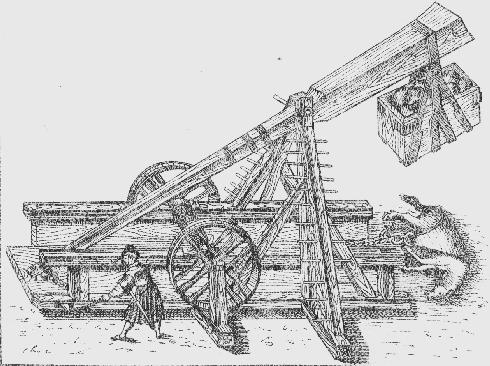
|
|
| The Mystery Trigger. Here we can see the next level of annoying lack of information - the "mystery" trigger, where the artist shows that there is one, gives some tasty hints, but doesn't show the actual mechanism. This is a drawing from 1507 when trebuchets were very old technology and, you'd think, well known. The artist has shown the 'gunner' holding a rope lanyard, about to trigger the engine. The trigger is apparently embedded in the base of the trebuchet at the rear, but what it is and how it engages the beam is hidden. All we know is that a sideways pull will set it off. |
|
|
|
|
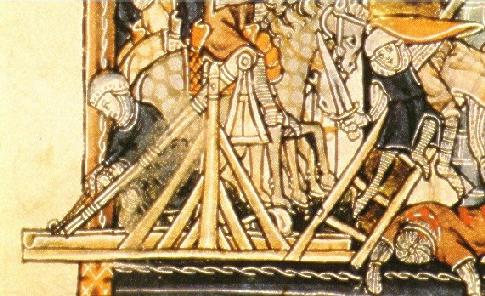
|
|
| The Mystery Trigger II More lack of information - and another "mystery" trigger. In this beautiful illustration the 'gunner' has a lanyard and is operating something right down near the end of the beam. Whatever it is the rope appears to pass through a loop on the side of the base. (Purely speculation - but if you, like many modern trebuchet builders, wish to use a trigger mechanism based on a pin being pulled out, having the rope pass through a ring makes it a lot safer and ensures that the pull is at the correct angle) |
|
|
Modern needs and interpretations. The Kolderer illustration above shows the requirements of safe trebuchet triggering being met - eg a good stand-off distance achieved by using a rope lanyard, and the 'gunner' off to the side rather than in danger at the rear. Modern reconstructions try to achieve these same conditions with a high level of reliability. One way to do this and prevent accidental self-firing is to have the action of the trigger at right-angles to the pull of the beam. |
|

|

|
|
|
|
|
Although evolved separately, the two designs
converged fairly closely. They represent the solutions that came to
mind to 20th century people with interests in blacksmithing. Both systems work well, but neither can claim to be based on historical illustrations. They're real claim to fame is that neither have ever caused an accidental firing and both allow a release with little pulling effort on the lanyard. Other solutions, of course, are possible. |
|

|

|
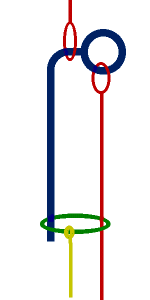
|
|
|
|
|
|
Some modern trebuchet and onager builders make use of other technologies. The photo & diagram on the left above show two different Wichard Pelican quick-release fastenings, made for use on yachts. These have the advantage of high-grade professional manufacture, so the higher price is off-set by reliability and "user confidence". The drawing on the right is by Ron Toms and shows a home-built version working on similar principles (a latch pivoted at the top and hauled down so that the mechanical advantage is huge and very little effort is required to release the load.) Ron's drawing is remarkably similar to one style of improvised farmers' gate latch used in Australia. |
||
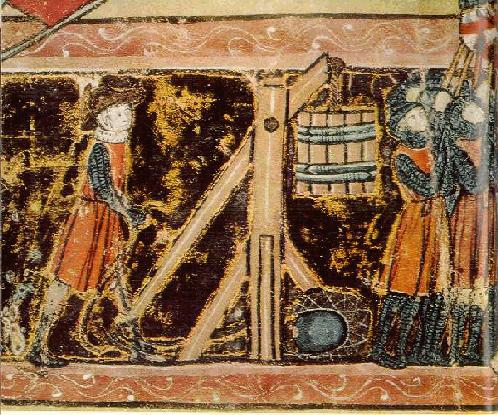
|
|
| Just to provide a tantalising hint that something vaguely like the Grey Co trigger was once used, here's a picture which might show a trigger with a handle .. or it might just be a rope, background detail or even damage to the image. The picture's quality lets us down.. | |
|
|
|
|
What you don't see in contemporary illustrations... The triggering method beloved of cartoonists and Hollywood (and a few modern treb builders) - that of using a knife or axe to cut a rope holding the beam down - never turns up in medieval or renaissance drawings. This may seem strange as it is likely to have had the advantages of simplicity and relatively low cost. (If you are employing masons to carve stone balls to throw away, why not a ropemaker to make consumable rope?). However, the historical record just doesn't support it. It's almost as if the siege engineers were offended by the idea of throwing anything away (other than the projectiles). To give another example, modern trebuchet fans often avoid using proper pouched slings by tying a length of rope to the projectile and throwing it away along with the rock or whatever. You never see this happening in the illustrations either. Just how expensive was rope? |
|
| |
|
|
What is in the Illustrations... (1) Mallets Many pictures show the 'gunner' holding or wielding a mallet, even if it's not clear what he's going to hit. In some illustrations he is giving the thing a dramatic swing, in others he's just waving it about. |
|
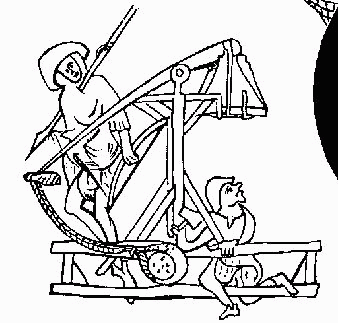
|
|
| The picture that has been adopted as the Grey Co Trebuchet emblem shows just such a crewman with his baton of office, the mallet, in his hand.... but there's nothing to hit. | |
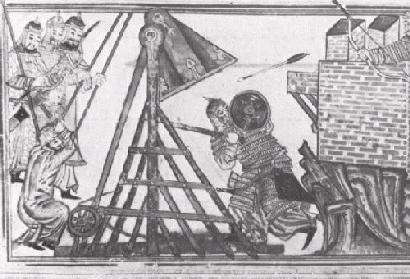
|
|
| Here the crewman is definitely going to whop something. He has his mallet raised - but whatever is about to get hit is down below and behind the machine. Once again you can't see the "mechanism". | |
|
What is in the Illustrations... (2) Ropes and Posts .. In a few pictures you get to see something that looks improbable - a beam being held down by a rope that passes over the beam and is anchored (at least at one end) by having a loop dropped over a short post whose top is larger than its base - a little like mooring a boat by throwing a bight over a bollard. (sorry.. translation: a loop in the end of a rope thrown over a post). The little posts are angled outwards to help hold the rope from pulling off due to the upward and inward tension. |
|
 |
|
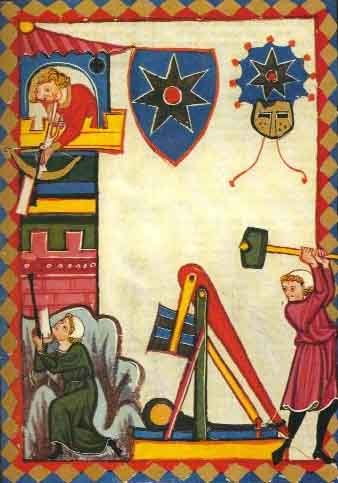 |
|
|
|
|
|
That these pictures are apparently unrelated
lends credibility to the idea that this is a genuine trigger system,
unless we invoke the old stand-by of asking whether this is an
"artistic convention" of the time. The rarity of any representation of trebuchet triggers augues against this... It's difficult to have a stereotypical way of drawing something if it's hardly ever drawn at all. |
|
|
These drawings give a clear view of the rope's
end and the image on the right shows our old friend the 'gunner' with
his mallet, about to whack the area around the peg and loop. We still can't see how it works, though.
The last possibility seems least likely (another good component being wasted - compare this with the "cut-rope" trigger notion- and there's the snapped-off end to get out of the hole). With regard to knocking the post out of its mount in the base... well, yes it could work and the pose of the mallet-wielder is consistent with it, but I have some doubts. It comes down to whether you would be able to fit the post in the base timber strongly enough not to have the beam pluck it out, but loosely enough to knock out when struck.
This brings us to the option of beating the rope up over the flare at
the top of the peg with a mallet. Moving a rope with a hammer certainly
works (even if my inclinations are to imagine some king of struck
"seesaw" lever to turn a downward blow into upward prizing). |
|
|
Both the rope-beating and the post-removing
options would require an upward blow - a blow that connects on the
upswing of a golf-like hit, perhaps? In both cases you are adding a
sudden upward shock to the steady pull of the beam. In fact, to achieve
either the simplest way would be to strike the rope an upward blow.
Something would lift out - either the rope off the post or the post out
of the base..
It could work. I do ponder about the reliability, though.... and the danger. |
|
| Experiments. We found ourselves unexpectly trying a variation of this trigger system at a Grey Co performance in 1999. On arrival at a country fair we discovered that we had accidentally brought the trigger of our old machine Gog instead of the one that fitted the larger Magog that was being demonstrated. The trigger was too short to engage the metal loop on Magog's beam. Having no alternative we tied a length of rope to the rear base timber, draped it over the hauled down beam and tied a loop in the end that would fit on the short trigger's finger. The system worked beautifully - the trigger pulled out of the taut rope loop cleanly and the rope flicked over the beam and out of the way remarkably well. |
|
|
Conclusion. There is nothing inherently wrong with a system that is based around a rope draped over the beam... by having everything happen off on the side it might even be superior in some ways to a central trigger that can foul the sling. The concept of this sort of trigger is also consistent with the winching technique shown in a number of illustrations and in Villiard de Honnecourt's contemporary description of the way the beam was wound down by a winch rope draped over the beam. |
|
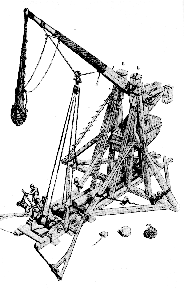
|
|
| Rather
than the ingenious complexity of, say, the fittings and tackles and
rope jungles of le Duc's 19th century reconstruction's (which, I should
add, have been built and work well), the trebuchet beams in the
medieval and renaissance illustrations appear clean and pierced only by
the axles and the release prong fittings at the tip. If the builders avoided supplying a fixture on the beam to attach the winch rope, would they add one for a trigger if a similar "draping" alternative existed?
|
|
|
|
|
| It
should be remembered, however, that those "mystery" trigger drawings
(such as Kolderer's), if taken as true and not deliberately
mis-leading, are not compatible with the draped rope system. The
prudent conclusion is that there was more than one style of trigger
mechanism in use during the hundreds of years that trebuchets were
being made. This hardly seems surprising.
Modern trebuchet builders are well advised to make their trigger systems as safe and dependable as possible - and to use a long triggering rope lanyard to allow them to set the machine off while standing well to the side. A medieval system that required a workman to stand amongst the machinery with a mallet was probably an acceptable risk in the context of a battle (where the risk of death from other sources was far worse) but for a modern hobbyist the prospect of dying because a recreational pumpkin throw went wrong seems a bit excessive.
|
|
|
|
|

|
Grey Company Trebuchet Page |
